mobile View, to the German Version tap the flag


- Democratic Federal Republic of Ethiopia
- own name: Itjopja Chzbawit Demokracijawit Republica
- former name: Abyssinia
• Flag
• Historical Flags
• Meaning/Origin of the Flag
• Coat of Arms
• Historical Coats of Arms
• Meaning/Origin of the Coat of Arms
• Aircraft Roundel
• Map
• Numbers and Facts
• History
• Origin of the Country's Name
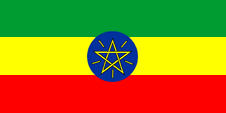
National and state and merchant flag,
ratio = 1:2,
Source, by: Wikipedia (D)






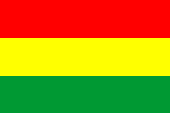
1897–1936,
National and state flag,
ratio = 2:3,
Source, by: Flags of the World



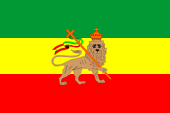
1941–1974,
National, state and merchant flag,
ratio = 2:3,
Source, by: Wikipedia (D)





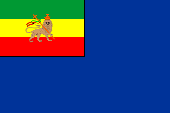
1941–1974,
Naval flag,
ratio = 2:3,
Source, by: Flags of the World



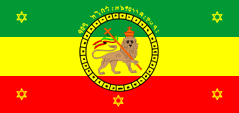
1941–1974,
Flag of the Emperor (front),
ratio = 45:95,
Source, by: Flags of the World




1941–1974,
Flag of the Emperor (reverse),
ratio = 45:95,
Source, by: Flags of the World



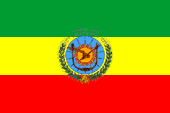
1974–1987,
State flag,
ratio = 2:3,
Source, by: Flags of the World,
Flaggen und Wappen




1987–1991,
State flag,
ratio = 1:2,
Source, by: Flags of the World



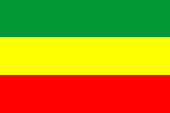
1941–1974,
National and merchant flag,
ratio = 2:3 / 1:2,
Source, by: Flags of the World




1974–1996,
National and merchant flag,
ratio = 1:2,
Source, by: Flags of the World




The today's flag of Ethiopia shows three horizontal stripes in green, yellow and red. In the center – above all – the coat of arms of the state, a blue disk with a thereupon lying down yellow pentagram. The green stands for the work and the fruitfulness of the land, the yellow for patriotism and justice, and red stands for bravery and the in the struggles for indpendence given blood.
The colors are also interpreted in a Christian way as a symbol of the Christian Trinity: Green stands for Holy Spirit, yellow stands for God the Father, and red for the son. The colors are also associated with Christian virtues. Green in this way hope, yellow represents charity and red stands for the faith.
The flag of Ethiopia was hoisted up for the first time – in inverted sequence of colors – in the year 1897. The colors of the flag have their roots in the trimming of the throne hall of emperor Menelik II. (1889–1913) with little pennants in this colors. From 1935 till 1941 Ethiopia was an Italian colony, and has not an own flag. After the retreat of the Italians follows the reintroduction, this time in the today usual sequence of the colors. In this form the flag stays unchanged, irrespective of the diverse coats of arms in the middle of the state flag, and is in the today's form official since the 6th of February in 1996.
The colors of the flag are even known as the "Panafrican colors": Perhaps in 1900 was the beginning of the Panafrica-Movement, wich wants to emphasize the commons of all people with black skin. The colour-triad green-yellow-red, wich used many african and even american countries in their flags after the independence, stands for the political unity of Africa, of all black People. The first country was Ghana in 1957. As the origin apply the colours of Ethiopia (Abessinia), the oldest independent state in Africa.
Source: Die Welt der Flaggen,
Flaggen und Wappen,
Flaggen Wappen Hymnen,
Wikipedia (D)


since 1996,
Coat of arms of Ethiopia,
Source, by: Wikipedia (D)

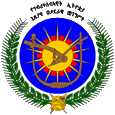
1974–1987,
Coat of arms of Ethiopia,
Source, by: Wikipedia (D)
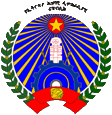
1987–1991,
Coat of arms of Ethiopia,
Source, by:
Wikipedia (D)

As coat of arms of the state Ethiopia was in use since older times the so named lion of Juda. That is probably borrowed from the Armenian lion and gets assumed. The lion of Juda was already in the middle ages valid as the scutcheon animal of the legendary priest Johannes. With the end of the monarchy was introduced a new coat of arms in 1975. It showed a large sun and a cogwheel (industry) on a blue disk, in front a plow (agriculture). This all was bordered with two oil-twigs. On this point, where both oil-twigs are crossing, appeared a medallion with the depiction of the lion of Juda.
With the acceptance of a new constitution was introduced a new coat of arms in 1987. This showed a depiction of the obelisk of Aksum, a large cogwheel, and a circular shield with behind situated arms, above that a red star. The coat of arms was surrounded by oil-twigs and palm tree fronds.
With the acceptance of a new constitution as federative democratic republic was introduced a new coat of arms on 6th of february in 1996, together with the resolution to use this on the national flag. It shows a blue disk with the golden depiction of a pentagram, the seal of Salomo. Between the five jags of the pentagram appear trapezoid beams. This symbol should shows the equality of all nationalities and religions by his regular construction, and at the same time portray the unity of the residents of Ethiopia. The golden beams stand for the future of the land.
Source: Die Welt der Flaggen,
Flaggen und Wappen,
Flaggen Wappen Hymnen

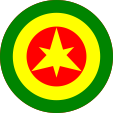
1941–1974,
Aircraft Roundel,
Source, by: Wikipedia (EN)

since 1996,
Aircraft Roundel,
Source, by: Wikipedia (EN)

Location:
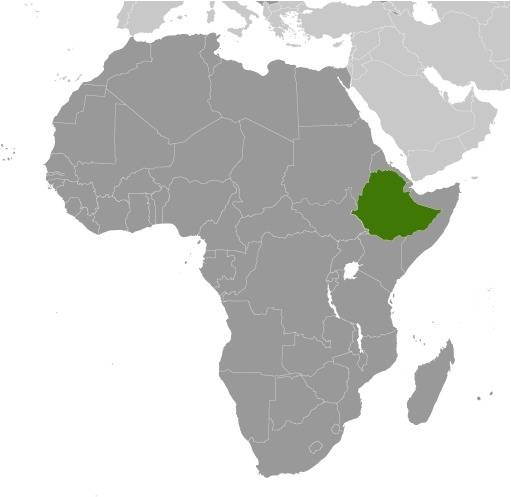
Source: CIA World Factbook
Map of the country:

Source: CIA World Factbook

Area: 426.370 square miles
Inhabitants: 112.079.000 (2019), thereof 27% Amhara, 34% Oromo (Galla), 4% Sidama
Religions: 63% Christian (mostly Ethiopian Orthodox), 34% Muslim, 2% Animist
Density of Population: 263 inh./sq.mi.
Capital: Addis Abeba, 3.352.000 inh. (2016)
official Language: Amharic
other Languages: English
Currency: 1 Birr (ETB, Br) = 100 Santim
Time Zone: GMT + 3 h
Source: Wikipedia (D)

1st to 5th centuty · Aksumitic Empire
13th to 18th cent. · first empire
1855 · second empire
1935–1941 · Italian colony
1974 · end of the monarchy
1977–1982 · Ogaden war against Somalia
1993 · secession of Eritrea
2001 · war against Eritrea
2018 · peace treaty between Ethiopia and Eritrea
Source: Atlas zur Geschichte,
Wikipedia (D)

The name of the country goes back to the ancient Greek name "aithiops", which means "burnt face", and referred to the dark-skinned inhabitants of Africa.
Source: Handbuch der geographischen Namen


![]()








































